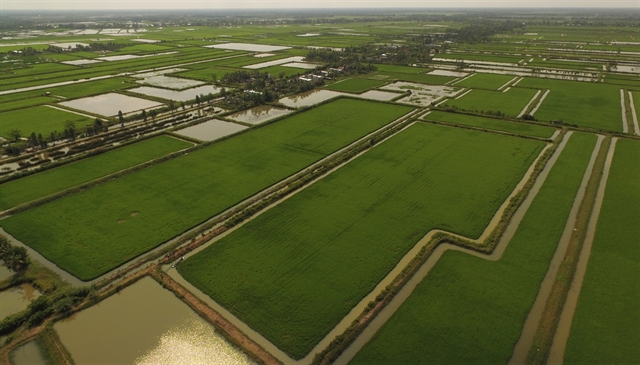 Society
Society

The Cửu Long (Mekong) Delta province of Cà Mau plans to convert this year nearly 2,000ha of unproductive rice paddies into fields where rice and aquatic species are rotated or perennial crops are grown.

|
| Large rice fields in Cà Mau Province. The province plans to switch to other crops on more unproductive rice fields this year. – VNA/VNS Photo Huỳnh Anh |
CÀ MAU – The Cửu Long (Mekong) Delta province of Cà Mau plans to convert this year nearly 2,000ha of unproductive rice paddies into fields where rice and aquatic species are rotated or perennial crops are grown.
The impacts of climate change, rising sea levels, saltwater intrusion, and flooding have affected agriculture and caused changes in cropping patterns in the province, according to its Department of Agriculture and Rural Development.
The department has been restructuring agriculture in recent years to suit local conditions and improve yields and farmers’ incomes.
To sustainably adapt to climate change, the department has zoned agriculture, invested in irrigation and transport infrastructure, trained farmers in vocational skills and given them financial support for buying seeds and agricultural machinery, determined that a switch to other crops will be based on local conditions and demand, and sought to develop agricultural value chains.
It aims to develop agriculture towards enhancing quality, building brand names and developing markets for produce, especially organic.
Last year it switched to other crops on 1,249ha of unproductive rice fields or rotated between rice and aquatic species, mostly shrimp.
The switch has brought farmers higher incomes, especially in the districts of U Minh, Thới Bình, Trần Văn Thời, and Cà Mau City, according to the department.
Nguyễn Văn Quân, its deputy director, said localities should effectively carry out the restructure this year.
They should develop large-scale farming areas to meet the requirements of the market and enhance efficiency, he added.
Agricultural extension
The Province People’s Committee has earmarked VNĐ7 billion (US$310,000) to improve the efficiency of its agricultural extension programme this year.
The province has instructed its Department of Agriculture and Rural Development to improve agriculture extension activities to increase yields, quality, efficiency, and sustainability.
It should mobilise individuals and organisations for transferring advanced techniques to farmers to develop value chains and protect the environment, expand effective farming models adapted to climate change, and promote farming models appropriate for each locality to improve farmers’ incomes and reduce poverty, the People’s Committee said.
The department should focus on improving the agricultural extension system to grow products that meet domestic market and export demands, it said.
Farmers in the province have adopted various effective models like rotating between rice and fish and rice and vegetable crops in the same field.
The model of two rice crops and one vegetable crop offers farmers an income of VNĐ80 million ($3,500) per hectare per year.
The country’s largest shrimp producing province has also adopted the shrimp – rice farming, shrimp – forest farming, extensive shrimp farming, and super – intensive shrimp farming models.
Last year it produced more than 218,000 tonnes of shrimp, 4 per cent more than in 2020, and exported more than $1.1 billion worth, up 9.6 per cent.
It has 280,000ha of shrimp ponds, or 40 per cent of the country’s total.
More than 19,000 of shrimp have received international quality certificates like global good agricultural practices (GlobalGAP), Global Aquaculture Stewardship Council (ASC), Best Aquaculture Practices (BAP), and Vietnamese good agricultural practices (VietGAP).
Farmers mostly breed black tiger shrimp.
The target this year is to produce 220,000 tonnes of shrimp, according to the department. – VNS